SpreadsheetConverter provides built-in forms processing. Follow the instructions below and you will submit your first online form to your own e-mail Inbox.
Using Excel to design electronic forms design is very convenient. The tabular format of the spreadsheet makes it easy to design good-looking forms. You can use fixed text and numbers, or use formulas to dynamically enter values into fields.
When you publish a form on the web, anyone with the link can fill out the form and submit it to you. Submitted forms are received in a designated e-mail Inbox. With the Advanced Submit Service, received forms are also stored in a database hosted by us. You can log in at any time to process or download your received forms.
In this tutorial, we will design a simple form in a spreadsheet, convert it to a web page, upload it to a web server and receive the first form response. Using only these skills, you can design any complex form required in your profession or personal life. Everything you need is included with your SpreadsheetConverter license.


When you create a form, you want to be able to collect the data provided by respondents. Unfortunately, the web browser cannot send the form data to you directly. You must use a server on the network to process the form, e.g. to convert the form contents into an e-mail.
The standard solutions for forms processing are typically rather hard to configure. Also, publishing forms on the web is prone to misuse. So-called “e-mail harvesters” continuously roam the web looking for e-mail addresses to use for unsolicited advertising in “spam” e-mails.
To avoid these drawbacks, SpreadsheetConverter provides a built-in hosted solution which is easy to configure and doesn’t expose the e-mail address the form will be sent to. When the “Submit” button on a web form is pressed, the data in the form is sent to one of our web servers, which converts the form fields into an e-mail and sends the form contents to a predefined e-mail Inbox. The basic service is free.
Before we continue, you need to define your web form in a simple spreadsheet. Just follow the steps below to start creating this form yourself. If you don’t want to practice using the product, the original spreadsheet can be downloaded here.
5. Enter the text “Name” in cell A2.
6. Move to select cell B2.
7. Locate the cell name field. It usually appears to the left of the formula field, above the column headings. It is the field that currently says “B1”. Give the cell B1 the name “Name” by entering that word into the cell name field and press Enter. The cell name will be used in the e-mail to identify the “Name” field.

8. Select the SpreadsheetConverter ribbon and make sure the task pane is visible.

9. Ensure that cell B2 is still selected. Click Text on the Widgets tab of the task pane. Marking a cell as a text field ensures that the cell’s contents are included in the e-mail as an input field, even if the cell isn’t referenced in a formula.

10. In the Text Field properties, tick the “Required” checkbox and press OK. This ensures that forms cannot be submitted without a name in the Name field.

11. Repeat steps 5-10 above to create a second input field “Email” in A3 and B3. Mark this field as required, too.
12. Select cells A1:B3 and create a frame around the form (Format cells > Border > Outline).
13. Here’s what the spreadsheet should look like at this point:

14. Save the form under the name “form”. Verify that Excel adds “.xlsx” or “.xls” at the end of the filename. If Excel warns you that there already is a document with that name, do not overwrite it. Save the spreadsheet under a different name instead, e.g. “form1”.
The conversion process will create a web page from the contents of the spreadsheet. This web page is stored in a special folder called the Conversion Path. The converted web page is automatically opened for instant testing in one or more web browsers. All of this is controlled by your SpreadsheetConverter Options.

In Excel, look for the SpreadsheetConverter tab at the right-hand end of the Excel menu. Click the tab to switch to the SpreadsheetConverter ribbon.
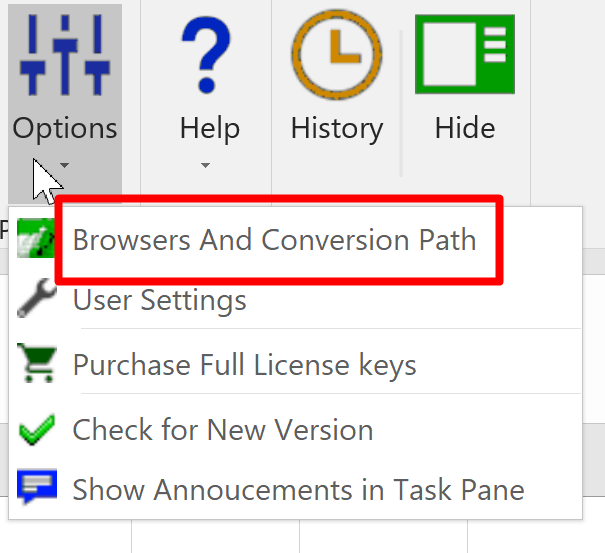
Open the Options menu. Select Browsers and Conversion Path.
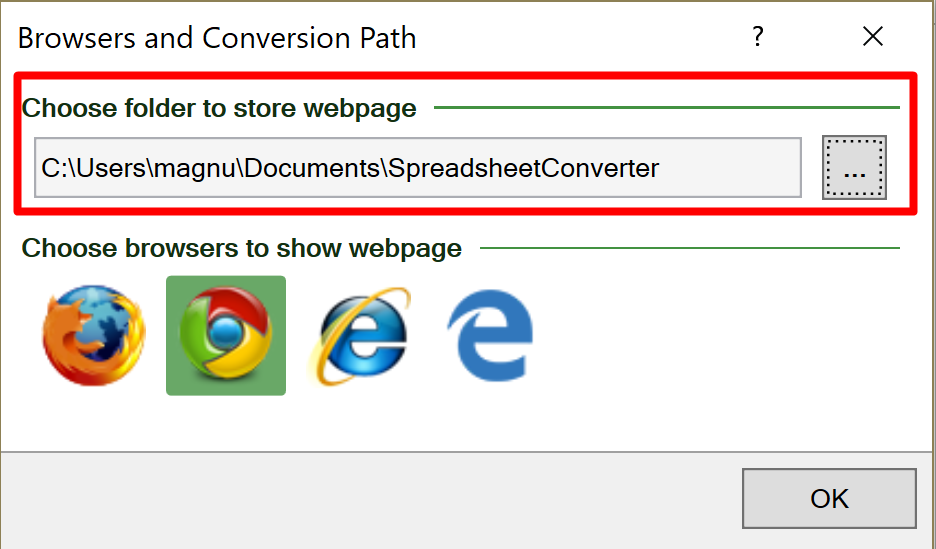
Accept the default location or click on the button to the right under Choose folder to store webpage and navigate to where you want SpreadsheetConverter to store the web pages it creates. All the converted web pages will be stored here, in the same flat folder structure, even if the source spreadsheets are in different folders. Each converted calculator or form will be enclosed in its own subfolder.
Select what web browsers you wish to test the result of each conversion in – click once to activate a browser, click once again to deactivate. Your converted web pages will open in all selected browsers directly after conversion.
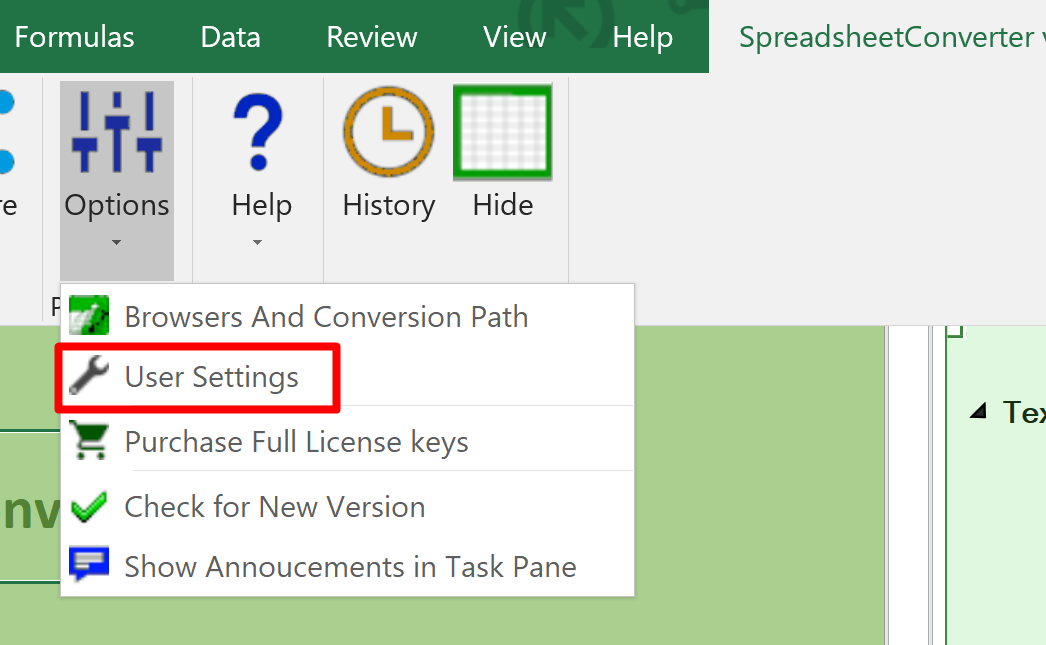
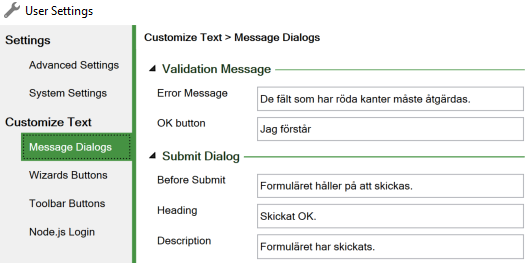
To change or translate any built-in texts, including the button texts, use the User Settings.
On the Message Dialogs tab, click on the arrows to expand the following sections:

In the SpreadsheetConverter ribbon, select Properties > Show so that the SpreadsheetConverter task pane becomes visible.

In the SpreadsheetConverter task pane, select the Worksheets tab so that the Worksheets Settings become visible.

By default, SpreadsheetConverter shows only the active worksheet. The additional worksheets usually contain only background information like tables and lists.
If your spreadsheet contains more than one worksheet, use these settings to make additional worksheets visible or hidden in the converted web page.

In the SpreadsheetConverter task pane, select the Workbook tab so that the Workbook Settings become visible.

In the Workbook settings, locate the Layout settings. This is where you select how you want the converted web page to appear.
Select Tabs to give each worksheet its own tab on the web page, just like in Excel.
When you start to make complex web forms, you may prefer one of the more advanced options here, e.g. to show the form as a wizard, where each worksheet is a separate step.

In the Workbook settings, locate the Input Cells settings. In Excel, all cells are unlocked by default and can be modified by the user. In the web page, we only want to open a few of the cells for input.
In the Auto mode, SpreadsheetConverter automatically unlocks cells that are referenced in formulas, and cells that contain a Text widget. You can also mark cells for input by giving them a unique background color, or by unlocking them.

Use the Web Page Title setting on the Workbook tab to set a title for each web page you create. The title appears on the tab for the web page in the web browser.
![]()

SpreadsheetConverter inserts a toolbar in the converted web page. The Toolbar position setting allows you to place the toolbar Below the spreadsheet, Above the contents of the page, or Both.
To completely remove the toolbar, unselect all the action buttons (see below).
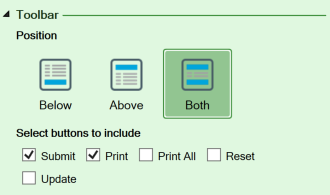
The toolbar can include a number of different action buttons. The most important one is Submit since this is the button that is used to send a completed form for processing. This checkbox must be checked for every electronic form.

At the top of the Workbook settings, there is a button for configuration of the forms submission process, i.e. how completed forms should be forwarded for processing. Click on the button to open the Configure Submit window.

Enter the e-mail address to which you want completed forms to be sent.
If you just want a one-time demonstration of what an e-mail from the Advanced submit service looks like, select Demonstration. Instead of being sent to your Inbox, a copy of the e-mail will open directly in your web browser every time you submit a new form.
Select the Advanced submit service if you have a trial or paid license for it, or select the Free submit service that is included with your SpreadsheetConverter license. The main difference between the two is that the Advanced service stores each form in a database, and formats the e-mail you get for each form submission exactly like the web form, which makes processing the form a lot easier.

Before you convert the spreadsheet to a web page, remember to save it in Excel. There are many ways to do this, e.g. to click on the diskette icon, hold down the Ctrl key and press S, or to select File > Save in the menu.
If you closed the spreadsheet, open it again so that it is visible in Excel.

SpreadsheetConverter has different “flavors”, i.e. it can generate the web page in different formats, depending on your needs. You convert your own spreadsheets for more than one technical environment. Select Html for this tutorial.

To start the conversion, click Convert in the SpreadsheetConverter ribbon.
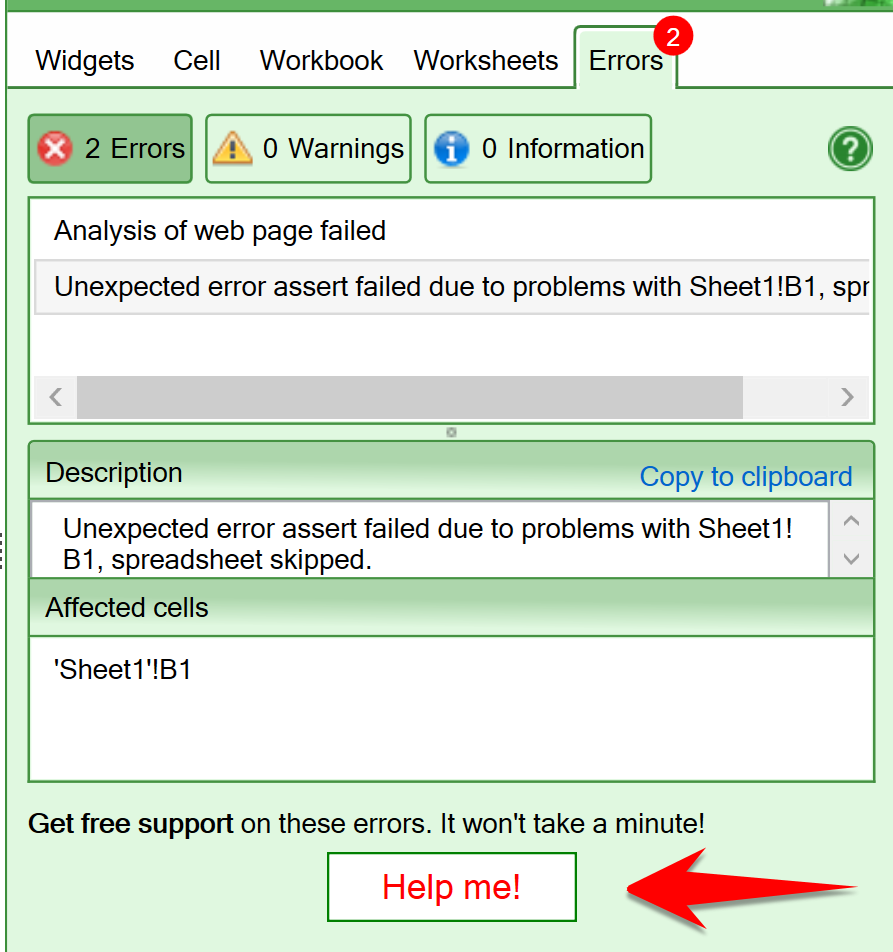
Ensure that there are only “Information” messages in the Errors tab. If you have any other messages, don’t hesitate to press the Help me! button to report your problem to our Help Center.
SpreadsheetConverter creates the web page in the folder you previously specified and opens the resulting web page in the browsers you selected.

Verify that the title of the page (in the window title or in the browser tab) is the web page title you set in the Workbook settings.
To test your new form, enter a name in the “Name” field and an e-mail address in the “Email” field. Press the “Submit” button. (The text on the button is defined in the “Configure Text” section of the preferences and may be different in your setup.)
Notice the default thank-you page. This is what your website visitors will see unless you provide your own thank-you-page.
Verify that the submitted form arrives at the e-mail address you specified. If the e-mail doesn’t arrive correctly, you may need to check your spam filter. Note that modern spam filters often reject incoming messages routinely, to see if the sender tries again, which may delay reception of the e-mail by several hours.

Note the “From” address, it will be used for all e-mails for this form. It is very important that you ensure that e-mails sent from this address pass through any spam protection you use.
Now we will test the form once more, this time without entering a Name. To open the form again, open the folder you selected for converted web pages in the SpreadsheetConverter Preferences. In that folder, there will be a new folder with the same name as the spreadsheet, e.g. “form”. Inside the folder there will be a “form.htm” web page. Double-click on this file to open the web form again in your browser.
Try to submit the form with an e-mail address, but with the Name field empty. You should receive a message saying that all required fields must be filled. You can change or translate this and all other message texts in Preferences > Customize Text.
If you have any problems or questions, don’t hesitate to contact our Help Center. We are here to help.
Upgrading to the fee-based Advanced Submit Service give you a lot of advantages. The e-mail now has the same layout as the electronic form, which can make it much easier to read. Also, you can store submitted forms on our server and download them only once a day or once a week. This makes it much easier to handle a large volume of forms.

As you can see above, the e-mail from the Advanced Submit Service also contains the submitted form as a comma-separated values file (form.csv) and a portable document format file (form.pdf). This can further simplify your processing of large volumes of forms.
To learn more about using SpreadsheetConverter for web forms, read our introduction to trouble-free forms handling with Excel.